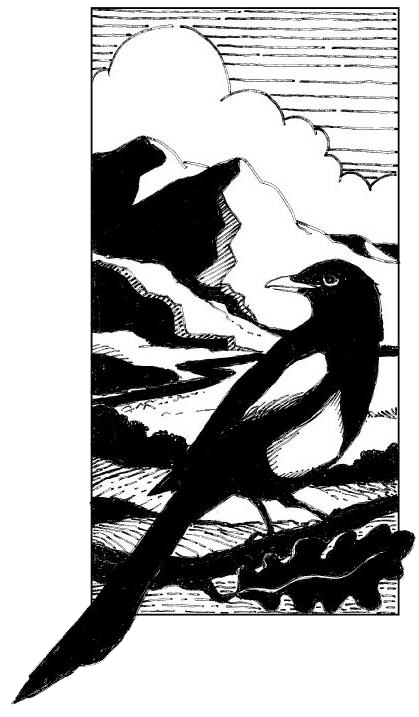Launching the Santa Ynez Valley Natural History Society
A Look Back at our Founding Year in 2000
By John Evarts, with history research assistance from Margie Popper
Published February 2025
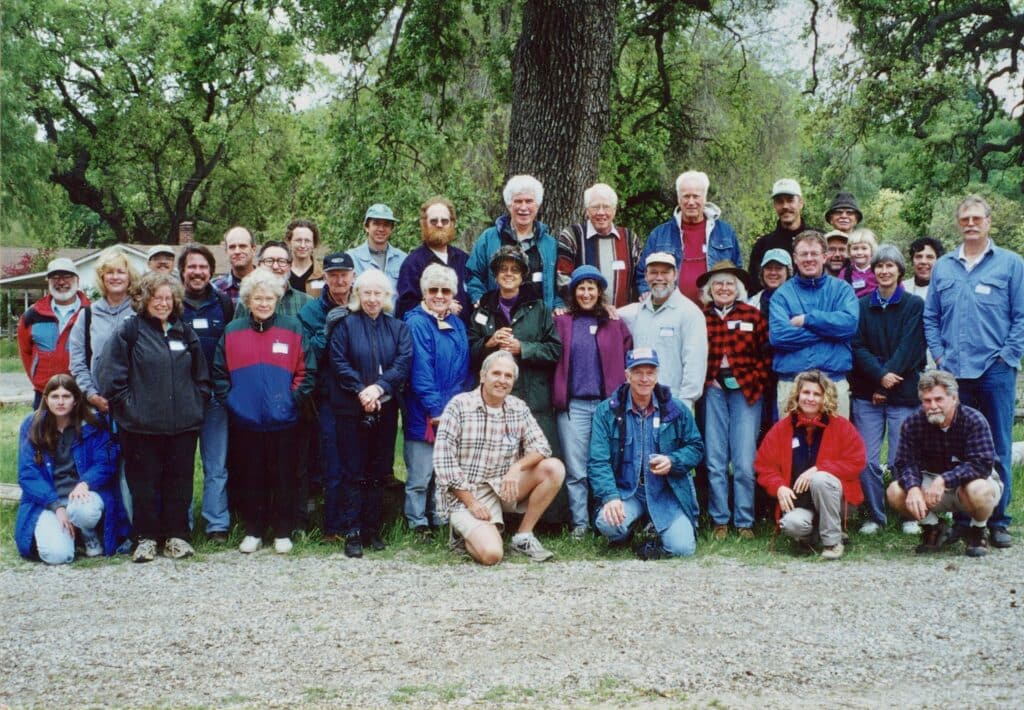
The Santa Ynez Valley Natural History Society will celebrate its 25th anniversary in 2025. This is an opportunity to acknowledge our achievements and reflect on the past and future of our small but thriving organization.
When we launched our educational nonprofit, we had an idea, but little else in the way of organizational scaffolding. At the time we invited the public to attend our founding meeting at Sedgwick Reserve in April 2000, we had yet to open a bank account, establish a mailing address, draft articles of incorporation, elect directors, or develop a mailing list from which we could build a membership base. We had not even settled on our name: would we be a society or an association? It would take several more years before we developed a logo. Fortunately, we did have a vision for our mission, and it has not changed since our founding: The Society is dedicated to the study, exploration, and appreciation of natural history in the Santa Ynez Valley region.
Our nonprofit is hardly unique in that its genesis was, in part, a response to events at the time. In 1999, Santa Barbara County was fully engulfed in a political fight over how to limit the loss of oak woodlands due to vineyard expansion. In response to what were known as the “oak wars,” civic-minded north county residents embarked on the “Oak Collaborative” process.
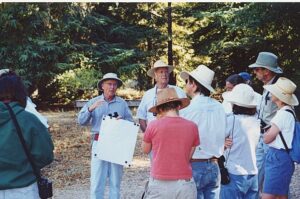
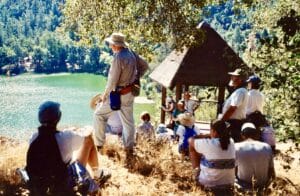
This series of sometimes contentious meetings was held at St. Mark’s-in-the-Valley in Los Olivos. They brought together conservationists and agriculturalists in an effort to balance oak tree protection with the operational needs of farmers and ranchers. New urgency was injected into these discussions when the Santa Barbara County population of tiger salamanders was declared an endangered species, a listing that would clearly impact some rural landowners.
Margie Popper, Dr. Richard ‘Dick’ Sage, and I were participants in the Oak Collaborative, as were some of you who are reading this. In the aftermath of these meetings, the three of us met several times to exchange ideas and strategies. We shared a belief that natural history education and awareness could be a way to find common ground and to engage people with very different perspectives when it came to issues such as rural land conservation and habitat protection.
We decided to test our theory that a substantial community interest in natural history existed within the Santa Ynez Valley. Dick invited two colleagues who were leading experts on salamanders, Dr. Brad Sherman and Dr. Sam Sweet, to give a public presentation on the Santa Barbara County tiger salamander. We also asked Paul Collins to participate since he had done extensive local field work in his capacity as Curator of Vertebrate Zoology at the Santa Barbara Museum of Natural History. Sally Isaacson, Director of Education at the Santa Barbara Botanic Garden, prepared a slide show to introduce the concept of the Society that would precede the lecture. Bert Etling, editor of the Santa Ynez Valley News, seemed receptive to the idea of this new organization. Our press release about the program carried his catchy headline, “Natural History Society takes Tiger Salamander by the Tail.” On March 14, 2000, more than 100 people came to Stacy Hall at St. Mark’s to learn about the life history of a local amphibian that most had never seen until that evening when Dr. Sweet presented a live animal from his lab at UCSB.
With a successful first lecture under its belt, the Society’s Interim Advisory Board invited the public to an April 16th founding meeting in the Studio at Sedgwick Reserve.
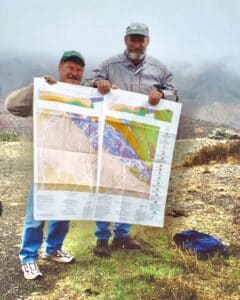
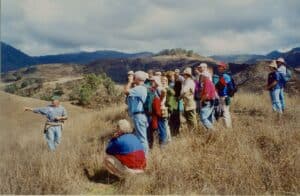
The announcement read, in part, as follows:
“We invite you to become a founding member of the Society. Are you interested in lectures, nature hikes, public school outreach, ranch tours, tree-planting, or something else? Come share your ideas. With your help, it promises to be a fun, stimulating, and rewarding first year.”
The 40 attendees generated 26 suggestions for lectures and 8 destinations for field trips. (Each recommended topic was subsequently covered by the Society.) Following our brainstorming session, Reserve Director Dr. Mike Williams led a botany walk. Among the participants that day were a number of individuals who went on to serve as directors or to play a role in helping shape the young organization, including Dennis Beebe, Jacqueline Broughton (first Ex. Director of Wildling Museum), Marge Erickson, John Evarts, Carey McKinnon, Margie Popper, Dick Sage, Dr. Evert Schlinger, Brett Stearns, John Schnittker, Mike Williams, and Don Wimpress.
At our next meeting on May 1, attended by 12, we finalized our organization’s name and established a three-person steering committee consisting of Evarts (chair), Popper (treasurer), and Sage (secretary) who would guide the Society while we began the process to incorporate as a nonprofit. The work of writing our by-laws was soon accelerated with the skilled assistance of attorney Marge Erickson, who helped us complete and submit our Articles of Incorporation; she later served as the President of our board.
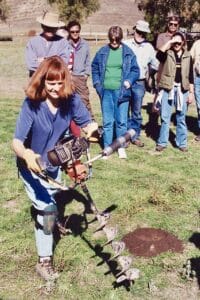
Most of the meetings in our first year were held in the Wildling Museum (now California Nature Art Museum), which was then located in the historic Hartley House in Los Olivos. The one exception was a second meeting at Sedgwick Reserve, at which time we announced Santa Ynez Valley Union High student Daniel Lahr as the recipient of our first “Research and Education Award” for students. His project on lichens and oaks trees went on to win First Place in the Life Science category at the Santa Barbara County Science Fair. (For a variety of reasons, the Society later discontinued the student science awards.) We also accompanied this meeting with our first field trip, an informal outing led by Dick Sage to examine plants and rocks at the Little Pine Fault zone near the head of Figueroa Canyon. We launched our fall 2000 season with a lecture in the former Superior Court space adjacent to Solvang Library with the support of Solvang’s new librarian, Carey McKinnon. This began our long partnership with the Solvang Library, which has co-hosted dozens of our lectures at this venue.
The lectures, field trips and workshops in 2000 featured excellent speakers and leaders, thereby setting a high standard for the ensuing years. We also covered a variety of topics, which would become another hallmark of the Society. A quick glance at the series of programs that followed our inaugural lecture on tiger salamanders is illuminating: “Western Pond Turtles and other Reptiles and Amphibians of the Santa Ynez River” with herpetologist Larry Hunt; “Seismology of the Santa Ynez Valley Region” with seismologist Dr. Elizabeth Cochran (a graduate of Solvang Elementary and SYV Union High School); “Natural History of Zaca Lake” with wildlife biologist Dr. Fred Emerson; “Hiking the Little Pine Fault: Geology of the upper Sedgwick Ranch” with geologist Helmut Ehrenspeck; “Valley Oak Regeneration in Santa Barbara County” with oak experts Drs. Frank Davis, William Tietje, and Claudia Tyler.
In November we submitted our finalized Articles of Incorporation to the state and appointed seven Directors who were also signatories on our application. Since then, our by-laws have only been amended in very minor ways, which is perhaps a testament to the care and forethought that went into their original wording. To date, 35 individuals have served on our Board of Directors. We now operate with a member-elected nine-person board. The current directors come from all walks of life (including three individuals with a Ph.D.) They work closely with our Membership Coordinator and current Board President (Marion Schlinger), Chief Financial Officer (Margie Popper), and Website Manager (Liz Gaspar).
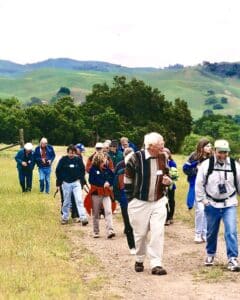
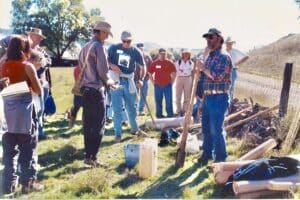
It is especially rewarding to take stock of what we have offered to our members and the public at large during the last 25 years. Since its founding, the Society has hosted about 150 lectures, of which 25 or more have been author events associated with newly published natural history books. A skilled corps of naturalists drawn from within our organization and the region have led nearly 160 field trips, ranging from the Channel Islands to Morro Bay and inland to the summit of Mount Pinos. We’ve given 20 workshops with hands-on projects, such as building bluebird boxes and planting oak trees. The scope and diversity of natural history subjects featured among our nearly 350 lectures, trips, and workshops is truly impressive. Each of these learning opportunities has been free or low-cost, and all of this has been orchestrated by a grass-roots nonprofit that is almost entirely dependent on volunteers.
Like most organizations, we have changed to keep up with advances in technology. After meeting in person at various locations around the Valley, our board now convenes online. Our newsletter, which began as a single one-color page sent via U.S. mail, was expanded to its current multi-page full-color format by past board President Marc Kummel, who named it “Magpie Calls.” The first iteration of our website, designed by past board President Ken Doud, went live in about 2010. Our lectures are now offered to in-person audiences and simultaneously live-streamed. Since 2020, most of them have been recorded and posted on our website.
One of the long-term challenges we face is the aging demographic among our trip leaders, members, and directors. This problem is not unique to the Society. It does, however, raise the question of how we can stay viable and relevant for another 25 years. Accessible science-based natural history education is needed now more than ever. With the ongoing and much-appreciated support of its members, trip leaders, and partners in the community, the SYVNHS could well prosper for another 25 years.
